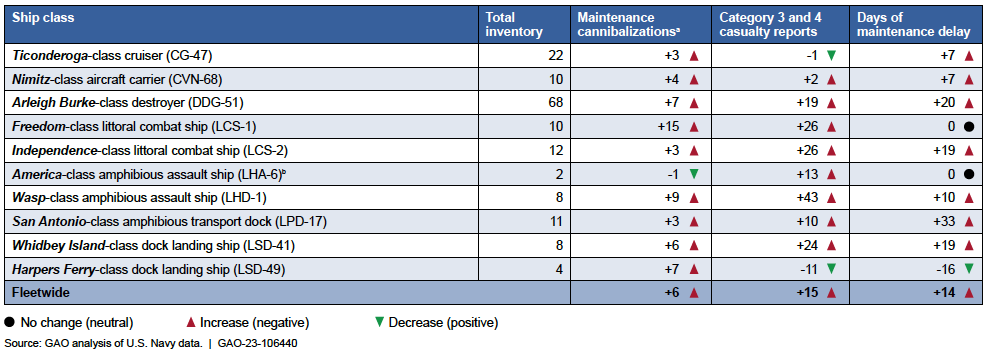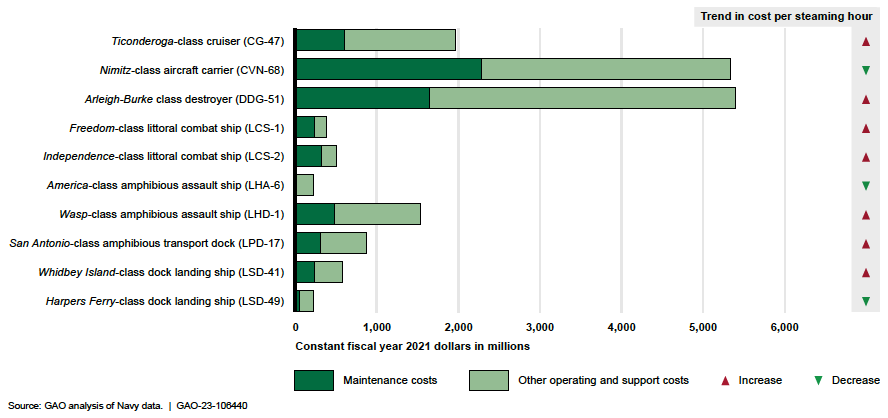The following is the Jan. 31, 2023, Government Accountability Report, Weapon System Sustainment Navy Ship Usage Has Decreased as Challenges and Costs Have Increased.
From the report
Sustainment Challenges Have Worsened across the Ship Classes Reviewed
GAO reviewed key sustainment metrics for 10 ship classes and found that from fiscal years 2011 through 2021, these classes faced persistent and worsening sustainment challenges. Specifically, the number of maintenance cannibalizations (working parts removed and reused elsewhere due to parts shortages), casualty reports (reports of events that impair ships’ ability to do a primary mission), and days of maintenance delay (days beyond the scheduled end date for depot maintenance) have each increased, while steaming hours (the number of hours a ship is generally in an operating or training status) have decreased. Additionally, the Navy is not fully or accurately tracking other metrics—operational availability and materiel availability—that the Department of Defense and the Navy have determined are key to assessing ship effectiveness despite a prior GAO recommendation to do so.
Changes in Sustainment Metrics per Ship across Selected Navy Ship Classes, Fiscal Years 2011 through 2021

Operating and Support (O&S) and Steaming Hour Costs Have Increased
Total O&S costs increased by about $2.5 billion from fiscal years 2011 and 2020 for the 10 ship classes GAO examined, including a $1.2 billion increase in maintenance costs. The Navy also added about 33 ships to these classes. Collectively, the number of steaming hours for the ships declined over the timeframe.

GAO found the average O&S cost per steaming hour—used to measure the cost to provide operational steaming hours—across the 10 ship classes increased from fiscal year 2011 to 2020. Specifically, most ship classes we reviewed experienced an increase in O&S cost per steaming hour across the timeframe.
Operating and Support Costs, by Ship Class, Fiscal Year 2020 and the Ship Class’ Trend in Average Cost per Steaming Hour, Fiscal Years 2011 and 2020
The increase in O&S cost per steaming hour occurred for several reasons. First, a decrease in steaming hours contributed to the increase in cost per steaming hour. Second, GAO’s prior work shows that a number of other challenges have increased sustainment costs for ships, such as maintenance delays that have resulted in some ships deferring maintenance. Over time this situation has resulted in worsening ship conditions and increased costs to repair and sustain ships. GAO has made dozens of recommendations, which the Navy has generally concurred with, to improve the Navy’s sustainment of its ships. While taking actions, the Navy has not fully implemented many of GAO’s recommendations, including that the Navy
- establishes performance goals and measures to better manage deferred depot maintenance backlog;
- better track data on and address challenges with executing intermediate maintenance periods; and
- take steps to ensure that new ships are reliable and can be sustained as planned when procured.
Why This Matters
The Department of Defense (DOD) spends tens of billions of dollars annually to sustain its weapon systems in an effort to ensure that these systems are available to simultaneously support today’s military operations and maintain the capability to meet future defense requirements. Costs to operate and sustain the 151 Navy ships included in this review totaled approximately $17 billion in fiscal year 2020. GAO’s past work has shown that the Navy has faced significant readiness challenges over the last decade. This is a public version of a sensitive report issued in December 2022. GAO removed specific details on steaming hours that DOD deemed sensitive.
How the GAO Did This Study
GAO initiated this work due to: 1) continuing interest in the operational availability and O&S costs for major weapon systems; and 2) as part of our response to a provision in section 802 of the William M. (Mac) Thornberry National Defense Authorization Act for Fiscal Year 2021 for us to report on sustainment reviews conducted by the military services with a specific focus on O&S cost growth. GAO reviewed documentation and interviewed program office officials to identify reasons for the trends in key sustainment rates and O&S costs as well as any challenges in sustaining the selected ship classes.
Download the document here.






